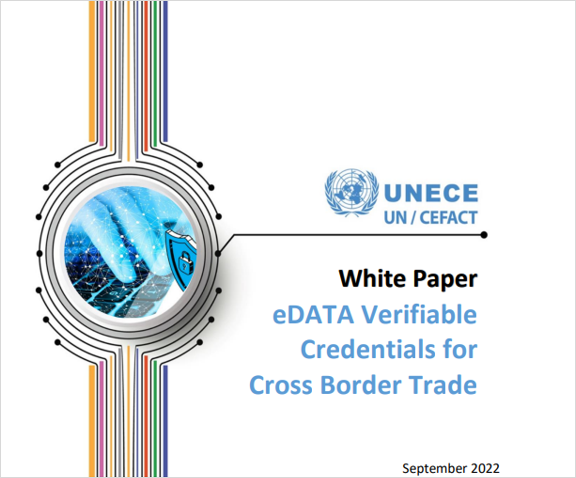How to use it
eDATA Verifiable Credentials for Cross-Border Trade
Published 28 February 2023
Supply chains have become more complex and globalized over recent decades. At the same time, economies and consumers are demanding more and highly accurate information about goods crossing their borders and entering their homes. The United Nations Centre for Trade Facilitation and Electronic Business (UN/CEFACT) offers a model for digitization of cross-border trade that may help address this complex challenge.
Here’s how to use the White Paper on eDATA Verifiable Credentials for Cross-Border Trade by UN/CEFACT.
Why is the UN/CEFACT white paper important?
The complicated reality of goods trading in our modern world presents a serious challenge for those wanting more information about items crossing borders while also reducing costs and simplifying cross-border processes.
The UN/CEFACT white paper describes, from concept to implementation, one possible tool to address these challenges: a “scalable operating model for digitization and trust of cross border trade based on verifiable credentials, linked data, and decentralized identifiers.” By adopting this tool, economies can transition to completely digital systems quickly while improving market access opportunities and border security.
How to find the key insights
Business Drivers
- The cost difference between selling a good internationally and domestically (cost of trade) remains high; about 30% of that cost comes from border-related measures like compliance, information, and security. Small reductions in costs can have a significant impact on increased export volumes. (p. 6, Figures 1 and 2)
- Up to 90% of global trade relies on trade finance (letters of credit and insurance); as of 2021, the gap between finance requested and granted was US$1.7 trillion, largely impacting small businesses with low-value shipments. Reducing uncertainties and increasing profitability with verifiable and efficient procedures can increase the availability of trade finance. (p. 7, Figure 4)
- Verifiable credentials can counter illicit trade in counterfeit cigarettes and pharmaceuticals; provide end-to-end traceability for transparency in sustainable and ethical supply chains; and help customs authorities combat illicit imports, duty evasion, and border risks. (pp. 8-10)
- Other tools, like peer-to-peer and shared hub architectures exist but are hard to scale and access by less developed parties. (p. 11)
Verifiable Credentials (VCs)
- VCs (passports are one example) have three key parts: a header that includes issuer and subject identities and issue dates; a set of claims; and cryptographically verifiable proof that all parties are who they say they are. (p. 12, Figure 7)
- VCs are decentralized: a VC proves authenticity without any need to contact the issuer. Decentralized identifiers enable verifiable digital identity as determined by the decentralized identifier’s owner (not the issuer). (pp. 12-13)
- As digital versions of paper documents, VCs can be implemented without interruption to existing business processes. VCs preserve privacy by allowing users to reveal only a subset of claims to anyone verifying the credential, and are cryptographically secure, nearly impossible to fake, and can be verified easily and automatically. (p. 12)
- VCs can be linked together to create trust graphs connecting multiple verifiable claims to create more value; specific information can be redacted to protect privacy in the chain. (p. 14)
- A trust anchor, such as a government agency, issues credentials that are widely trusted in a community; trust anchors can play an important role in issuing standard licenses as VCs to ensure the trustworthiness of a transaction. (p. 15)
Implementation Guidance
- Choose standards-based, interoperable technology platforms. (p. 18)
- Use UN/CEFACT standard vocabulary for cross-border trade terminology used in VCs. (p. 19)
- Empower national trust anchors to do digitally what they already do manually. (p. 19)
- Enable citizens and companies to link self-issued VCs to their national identity certified by their government. (p. 20)
- Allow information in VCs to be selectively redacted to protect privacy. (p. 21)
- Incentivize the use of digital VCs for import documentation and clearance. (p. 21)
- Digitize in a “paper-friendly” way to avoid disruptions to existing complex supply chains, meet legal requirements for nations requiring paper, and facilitate the uptake of digital tools. (pp. 22-23)
- Issue all cross-border documents as digitized but paper-friendly VCs as soon as possible, regardless of counter-party readiness. (p. 23)
How to apply the information in the Annexes
- The UN/CEFACT White Paper Annexes provide practical and useful information for implementing VCs for multiple key cross-border trade documents.
- This information includes both an assessment of the challenges in presenting accurate documentation in cross-border trade, and the solutions VCs can provide to those challenges. Annex 2 gives useful links to UN/CEFACT’s continuously updated websites to guide the adoption of VCs.
Conclusion
The UN/CEFACT white paper makes a strong case for the adoption of an innovative and useful tool to address complex challenges in cross-border trade. Customs officials and policymakers around the world would do well to read through the technical scenarios and problem-solving suggestions carefully and consider whether this tool would help them achieve their policy goals more efficiently and inexpensively, and to the benefit of their companies engaged in trade.
Complementary reports and analysis
HINRICH FOUNDATION
- Digital trade facilitation, fintech, e-commerce
- Small and medium-sized global traders are banking on blockchain
- Blockchain could replace mounds of paper at the border
- Where have you been? Blockchain for tracking goods in trade
EXTERNAL RESOURCES
- Standards Toolkit for Cross-border Paperless Trade – World Trade Organization and International Chamber of Commerce
This Standards Toolkit provides a starting point to guide users in their digitalization journey. - Reducing the red tape around supply chains – Third Way
Examines what trade facilitation entails and how it impacts supply chains. - Why it costs so much to move goods around Africa – The Economist
Explains transport costs in Africa by disaggregating possible factors and using empirical evidence.
© The Hinrich Foundation. See our website Terms and conditions for our copyright and reprint policy. All statements of fact and the views, conclusions and recommendations expressed in this publication are the sole responsibility of the author(s).


